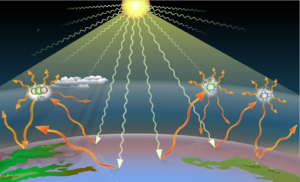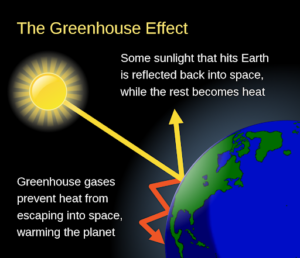Climate Skeptic Part 1: Is Climate Change Really Happening?
Part 1 of 7
Authors: Amber Bieg, Deb LaSalle, Zach Bell, Heather Colwell, Kevin Winslow, Jay Schuyler, Alaina Sisco, Mitch Samson
Is Climate Change Really Happening?
Maybe you’re not convinced climate change is happening, or doubt that it’s human-caused. Or maybe it’s something you’re on the fence about as you haven’t had time to fully investigate it. That’s okay — you’re not alone. While there is growing consensus around climate change and its impacts, many people in Idaho doubt climate science. As scientists, economists, and engineers, we believe skepticism is valuable; good scientists are always skeptical. Science involves exploring ideas, hypotheses, new data, and continually evolving theories. We hope this blog post will dispel some of the confusion and misconceptions on this topic, and shed light on the basic concepts.
Since the beginning of life on Earth, plants have absorbed the sun’s energy. Over thousands of years, those plants decompose, which ultimately creates stored energy in the ground. For billions of years, the Earth has metabolized that energy to produce fossil fuel.

To power our modern life and economy, we take this fossil fuel and, simply, burn it. Some of the chemicals resulting from this process make up the Earth’s atmosphere, while others dissipate or fall out onto the ground. Certain chemicals — like ozone (O3) — provide a protective barrier that causes radiation to bounce back into space. Others — like carbon dioxide (CO²) and methane (CH4) — help trap heat and energy from the sun. This is called the “Greenhouse Effect.” The higher the concentration of greenhouse gasses (GHG) in the atmosphere, the more heat gets trapped, resulting in a warmer planet.

But it isn’t as simple as the planet just getting warmer, despite the fact that average temperatures worldwide have increased overall (and will likely continue to do so). There are places on Earth that will begin to experience significantly colder temperatures on a regular basis.
This change in temperatures can be attributed to the way atmospheric currents move around the planet. Slight disturbances to atmospheric systems, like a seemingly insignificant increase in average ocean temperatures, can cause huge changes in what’s called the “jet stream.” This is a narrow, variable band of very strong, predominantly westerly air currents that encircle the Earth. Typically there are two or three jet streams in both the northern and southern hemispheres. It is for these reasons that many scientists use the term “climate change,” rather than “global warming.”
In addition to fluctuating changes in temperatures, temperature patterns, and wind currents, climate change results in more frequent and more dramatic weather patterns. This includes heavy rain and snow in some regions and heat and drought in others. These weather events can occur in the same year and in the same region, but in different seasons. Climate change, therefore, can be attributed to increased wildfires in the Northwest, and more frequent tropical storm activity in the East.
Based on observations and historic temperature records across the planet, climate change is well documented.[1] While the debate over climate change may seem like a somewhat recent topic, scientists have been concerned about it since the late 1800s, and the world has been debating its existence — and moving to mitigate its effects — since 1988. In June of that year, top scientists, activists, and politicians from across the globe gathered in Toronto for the first “World Conference on the Changing Atmosphere.”[2]
The most-alarming topic was the buildup of greenhouse gases or CO2. Attendees were astonished to learn that CO2 levels had risen from 315 parts per million (ppm) in the late 1950s (when monitoring first began) to 350ppm in 1988. What followed that summer was a record heatwave in North America, resulting in fires across the West and the largest fire-fighting effort in the U.S. at that time.[3] The 350ppm still is considered the point of no return for the safe level of CO2 in our atmosphere. Today we have reached 414ppm. Prior to the 1988 conference, NASA scientist James Hansen told the U.S. Senate to “stop waffling… the evidence is pretty strong that the greenhouse effect is here.”
References:
[1] USA Facts. Climate in the United States. August 2021.
[2] The Economist. Why tackling global warming is a challenge without precedent. April 25, 2020
[3] National Park Service. NPS.gov. 1998 Fires
